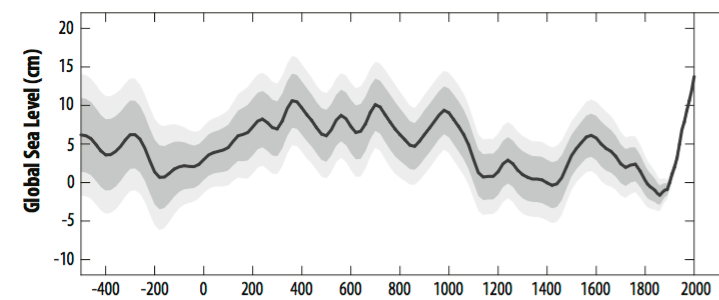The Oceans - Rising sea level linked to warmer seas, and melting ice
Sea level is rising, and there are several reasons connected to global warming.

Extra water enters the sea when ice melts from Antarctica, Greenland and other glaciers and ice caps.
The seawater also expands as it gets warmer, just like the liquid in a thermometer expands as temperatures rise. This is called 'thermal expansion.'

Investigating sea level rise involves scientists using many different methods, including satellites which map the surface of the sea.
It is also important to look carefully at older records from tidal gauges all over the world.
Global sea level rise from the 20th century to the last two decades has speeded up even more than scientists previously thought, according to a new Harvard study.
What could be the potential for sea level rise?
Atmospheric CO2 is now around 400 parts per million (ppm).


An international team of researchers has produced this graph of ocean levels, for a period of time going back to around 500 BC.
Extra water enters the sea when ice melts from Antarctica, Greenland and other glaciers and ice caps.
The seawater also expands as it gets warmer, just like the liquid in a thermometer expands as temperatures rise. This is called 'thermal expansion.'

Investigating sea level rise involves scientists using many different methods, including satellites which map the surface of the sea.
It is also important to look carefully at older records from tidal gauges all over the world.
Global sea level rise from the 20th century to the last two decades has speeded up even more than scientists previously thought, according to a new Harvard study.
What could be the potential for sea level rise?
Atmospheric CO2 is now around 400 parts per million (ppm).
It last reached similar levels during the Pliocene, 5.3-2.6 million years ago.

In the Middle Pliocene, the concentration of carbon dioxide in the air ranged from about 380 to 450 parts per million.
Global average temperatures were 2-3°C warmer than today.
Sea level rose by up to 20 metres in places.
So potentially sea levels could rise a long way as the Earth responds to the high levels of CO2 now in the atmosphere.
Sea level rose by up to 20 metres in places.
So potentially sea levels could rise a long way as the Earth responds to the high levels of CO2 now in the atmosphere.